For years, Anita Busch was like Old Faithful. Every time I saw her at a screening or a party, she always gave me a vaguely dirty look. Every…damn…time. Which is one reason why I enjoyed…no, not enjoyed…why I didn’t especially grieve over Nikki Finke’s respectful vivisection and entombment of the former entertainment journalist in this just-posted L.A. Weekly column. The subhead reads, “Pellicano charges are vindication for the former Hollywood reporter, but we’ve already buried her.”
Day: June 22, 2005
What…are you kidding? This is
What…are you kidding? This is fantastic. You can tell right away that Elizabethtown has a nicely seasoned mood, a tone that’s not quite this, that or the other thing but is definitely alive and absorbing and trying to dig down. You can feel the whimsy, humor, gravitas, regrets. Kirsten Dunst seems…I don’t know…hotter and more emotionally come-hither than in anything she’s acted in before, and something tells me this will be Orlando Bloom’s home run. (Or something approaching this…a triple?) This easily overrides the effect of those moderately dull school yearbook cast photos that appeared on the Elizabethtown site a week or so ago. Jane Fonda is advised not to click here — it’ll only depress her. Everyone else, feel free.
Could everyone I’ve been speaking
Could everyone I’ve been speaking to about doing a new column (and you know who you are) please re-contact me so we can finalize everything and get this stuff rolling? Thanks.
Witch Girls….Nicole Kidman or Kim Novak?
My hopes were up during the first three or four minutes of Bewitched because it starts out like Bell, Book and Candle, the 1958 film with James Stewart and Kim Novak.
Nicole Kidman, playing a cheerfully perky witch named Isabel Bigelow, says at the beginning that all she wants is to be loved in a normal everyday way by a regular “helpless” boyfriend who needs her. Not to be repetitive, but at this point I leaned over to Bill McCuddy, the Fox News anchor guy who was watching it with me last week, and I said, “This is Bell, Book and Candle.”
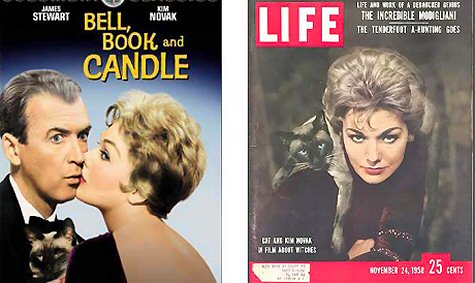
James Stewart and Kim Novak on DVD art jacket for Bell, Book and Candle; Novak’s November 1958 Life magazine cover promoting the film.
And almost as soon as I said this, Bewitched dropped this very relatable theme — an oddball exotic woman who wants to have a relationship with a regular schlub — and split itself into six or seven other directions and went all to hell.
It wound up being about personalities and letting Will Ferrell be Will Ferrell and the usual toxic (I think the standard adjective is “bubbly”) amusements that constitute your standard romantic-comedy-made-by-a-big-studio these days. It’s pure fizz, or is that giving the film too much credit?
And for this you can put the blame squarely on director and cowriter Nora Ephron and her cowriter sister Delia Ephron.
So a movie based on a TV comedy series from the `60s and early `70s, about an actual witch who just happens to get hired to play a pretend witch on a brand new remake of the Bewitched TV series. How coincidental is that?
This happens because the star of this new Bewitched series, an empty-cavity asshole actor named Jack Wyatt (Will Ferrell), happens to run into Isabel at Book Soup (the West Hollywood book store) and falls for her right away, partly because she’s beautiful but mainly because she can do that Elizabeth Montgomery/ Samantha nose-wrinkle thing to perfection.

Here I am summarizing a totally inane plotline and hating myself for doing so and determined to stop right now.
The bottom line is that Ferrell is playing such a repulsively insecure twit and a run-at-the-mouth Hollywood phony that you can’t help but lose all feelings of empathy for Kidman’s Isabel because anyone being attracted to a guy with Jack Wyatt’s personality is fairly grotesque.
So with the foundation making no sense the whole thing is a waste of time, and that goes for the efforts of several appealing actors who’ve been given very thin, barely-written parts — Michael Caine, Shirley MacLaine, Jason Schwartzman, Kristin Chenoweth….although I’m sure they were well paid.
The only walk-on role that really comes through is Steve Carrell’s third-act cameo as Paul Lynde’s “Uncle Arthur.” Like I said a few days ago, if only the Ephrons had decided to weave Carrell into the film as a major character, etc.
There is one amazingly funny moment, when Isabel wrinkles her nose and causes a large chandelier to fall upon a character neither she nor we like. Radical! Then we realize the sequence has been one of those cheap-ass fantasy projections that isn’t really happening.
Opposite of radical!
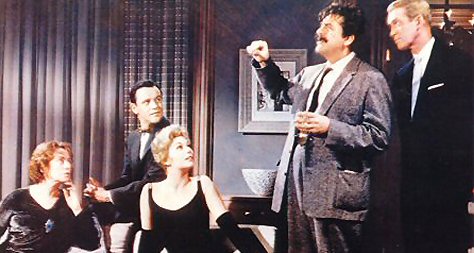
(l. to r.) Elsa Lanchester, Jack Lemmon, Kim Novak, Ernie Kovacs, James Stewart.
The rule used to be if Larry King turned up in a film (i.e., playing himself interviewing one of the fictional characters), it sucked. The same rule applies today if the shamelessly unctuous James Lipton, the Actor’s Studio interviewer, shows up in the same way, which he does in Bewitched.
I need to stop the nitpicking and segue back to Bell, Book and Candle, which the Bewitched TV series was partly based upon (along with that Rene Clair comedy I Married a Witch, with Veronica Lake and Fredric March).
The basic idea behind John van Druten’s original stage play, which was first performed in 1950, was that seemingly weird people (i.e., quirky individualists) are like everyone else in that they want someone to love them in a very soothing and traditional way.
Gillian Holroyd, played by Kim Novak in the Richard Quine-directed film, has her exotic leopard-skin-leotard lifestyle and the power of witchery at her fingertips, and all she wants in the end is a cute stodgy guy in a suit to love her and make her feel the way we all want to feel.
Not a very hip idea, granted, but…well, don’t we? Don’t we all want love and security and spotless kitchens and tidiness, on top of great sex and the other stuff? The most peculiar and aloof among us want this…even if they won’t act on it, much less admit it.
Van Druten’s witches and warlocks living in Greenwich Village are, of course, stand-ins for the beats and bohemians of the late `40s and `50s. Screenwriter Daniel Taradash stayed with the basic metaphor. Novak’s Gillian, Jack Lemmon’s Nicky (Gillian’s goofily irresponsible younger brother), Elsa Lanchester’s Queenie…all of them mildly eccentric, anti-conformist, below-14th-Street types.
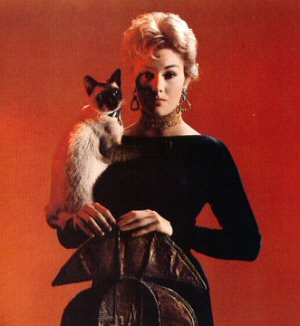
Kim Novak and “Piewacket” in Bell, Book and Candle. Was it Candy Darling or Holly Woodlawn who did that terrific imitation of Novak calling for Piewacket (“Pie! Pie!”) in one of those ’70s Paul Morrissey films?
At first Novak just wants to sexually sample the straight-arrow uptown book publisher Shep Henderson, played by James Stewart, which she manages by casting a spell. But then her vulerable side comes through and she falls in love with the guy. And to have and hold him, she is later told by Queenie, she has to give up her witchy powers and become like everyone else.
A metaphor for tedious Eisenhower-era conformity, okay, but also for the process of surrendering certain selfish perogatives and “giving it up” to make a relationship work.
It’s a widely understood theme, which is why Bell, Book and Candle, sappy as it may seem from your basic hipster perspective, is still performed in regional theatre companies today, and why the Columbia Tristar Home Video DVD of the film is still a mildly pleasant thing to sit through. You can feel what Kim Novak is feeling, what she wants. Hokey as it is, the story connects.
Plus it has a tasty supporting performance by Ernie Kovacs as an alcoholic writer. I love that the slurry-voiced, shaggy-haired Kovacs is in the bag for the entire film and is always scrounging around for “a little post-Christmas cheer.” And I love the way he chuckles when a realization hits him.
(There’s an article in how alcoholics in movies used to be reliable comic figures, or even portrayed as lovable because of their alcoholic personalities. Lee Marvin in Cat Ballou , Dudley Moore in Arthur, Arthur O’Connell in Anatomy of a Murder, etc.)
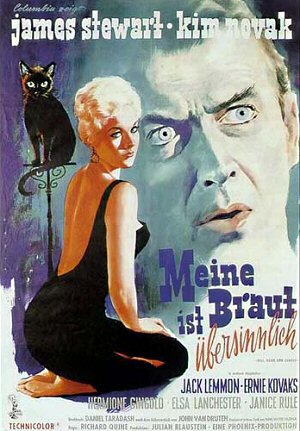
I’m not saying Bell, Book and Candle is a deeply profound thing, but if the Ephron sisters had focused on van Druten instead of swizzle-sticking the formula of an old TV series that was basically about domestic female empowerment (all Samantha has to do is wrinkle her nose and all predators are stopped in their tracks), they would have at least had something.
They would have had an adult love story about a recognizable emotional tendency or current instead of what Bewitched is now, which is nothing.
But if they’d gone this way they couldn’t have used Will Ferrell as the book publisher be cause he can only play insecure boobs, and one of the main reasons they made this film was because Ferrell sells tickets to young men, so they kept Ferrell and booted Bell, Book and Candle and went for the easily identifiable TV series hook and everyone cashed their checks, and this is why almost everything made by a big studio these days stinks.
Scrappy Guys
I first saw Scott Caan’s Dallas 362 during the ’03 Toronto Film Festival, and now it’s finally getting a New York opening this Friday (6.24) at the Village East. It’s played here and there around the country (Ohio, Austin, Los Angeles) and hasn’t exactly caught a wave, but it’s a tangy, smartly written, nicely performed first film.
That’s not damnation with faint praise. I’m just giving it a solid B-plus and saying it’s worth seeing because Caan gets a whole lot of things right. It’s partly a middle-American Mean Streets and partly a dark relationship comedy. It’s got spunk, personality and at times a wack sense of humor, which is nearly enough to take the film across the finish line in itself.
It’s a low-budget male relationship movie, which yanks it out of the running right away as a date movie. And except for a pair of older boomer-aged characters played by Kelly Lynch and Jeff Goldblum, it’s mostly about some fringe-y, wild-ass GenX types with self-destructive behavior patterns. And we all know that demimondes of this sort tend to play best with esoteric DVD renters.

Not surprisingly, and to some extent autobiographically for Caan, Dallas 362 is a dear-dad movie. It contains echoes of the writer-director’s relationship with his father, actor James Caan, although Scott casts himself in a second-lead role and gives the lead to Shawn Hatosy, a squatly-built young actor with Irish skin and small dark-brown eyes that made me think of that Michael Caine line in Get Carter — “piss-holes in the snow.”
Hatosy is better than adequate in Caan’s film, but he doesn’t have star chemistry. Caan, who does — he’s always had an effortlessly grounded macho prescence and a ready-to-pounce intensity — should have played the lead, and Hatosy, good as he is in Rusty’s shoes, should have played Dallas.
It’s interesting that it’s Caan who’s front-and-center in the release poster with Hatosy standing behind him.
Rusty (Hatosy) and Dallas (Caan) are a couple of L.A. guys in their mid 20s who are always getting into bar fights. They keep telling themselves it’s always the other guy’s fault, but they’re obviously into rage. Rusty, who’s slightly more stable than Dallas, is pushed into therapy sessions by his mom, Mary (Kelly Lynch), with an amiable, pot-smoking psychologist named Bob (Jeff Goldbum), who also happens to be her new boyfriend.
For the first 30 to 45 minutes, the movie is mainly about kicking around, chasing girls, meeting this and that edgy character, and getting banged up in pool halls and juke joints at night.
Dallas’s day job is collecting money for a bookie, but he’s working on two plans to rip off rich guys in their homes — one being the bookie he works for, and the other a guy he won’t know anything about until the night of the job.
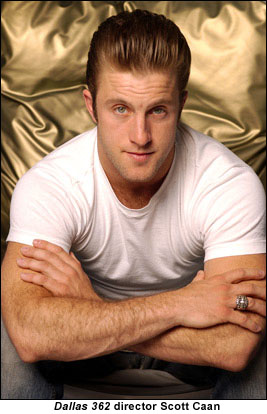
Rusty, meanwhile, starts getting in touch with his feelings during his therapy sessions with Bob. One revelation is that he’s pining heavily for his dead father, a rodeo rider who died after being gored by a steer, and wants to follow in his footsteps.
Another is his deep kinship with Dallas, whose loyalty and fearlessness makes Rusty feel safe, he says, even though Dallas is obviously pulling him in the direction of chaos.
The going-to-Texas dream has a roadblock in the form of Mary, who doesn’t want to endure another rodeo tragedy and has told Rusty to forget it.
What kind of 24 year-old doesn’t follow his dream because him mom says no? Maybe the kind who hasn’t quite realized what that dream exactly is…yet. But once Rusty achieves clarity on this, he starts edging away from Dallas, who is determined to pull off the two home invasion robberies despite his friend’s disapproval. Rusty is appalled at his friend’s recklessness, in fact, but he decides not to stand in his way either.
The real-life parallels or references? The younger Caan is obviously following in his father’s footsteps, both as an actor and a director,. James Caan was on a very reckless personal streak in the ’80s. He also had a liking when he was younger for outdoorsy macho stuff, including bronco riding, if I remember correctly.
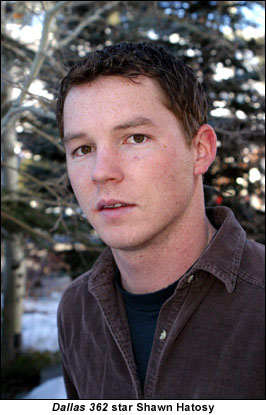
There are some occasional misfiring bits in Dallas 362, but nothing too bothersome. There’s a scene in a diner between Hatosy and a beautiful blonde stranger who walks in with lust (or something very close to that) in her eyes. Rusty tells the blonde he’d like to “save ” her by carrying her away, but can’t right now. Then he leaves without asking for her phone number, or giving her his. What the….?
The opening credit sequence — a series of black-and-white photos portraying Dallas and Rusty’s raucous nighttime adventures — is magnificent.
Bottom line: Dallas 362 is a highly assured debut of a new writer-director with a genuine sense of style. Caan’s dialogue is extraordinary at times, and he gets top-notch performances out of everyone. The result is far better than most of the mainstream pics playing at your local plex. Naturaly, given all this, it’s had some difficulty finding its audience.
Here’s the site .
Grabs
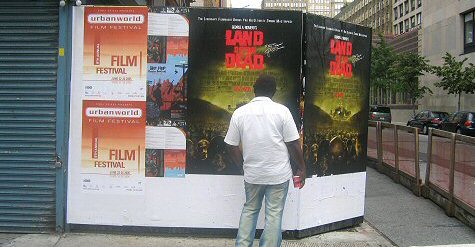
8th Avenue and 22nd Street — Sunday, 6.19, 5:45 pm.
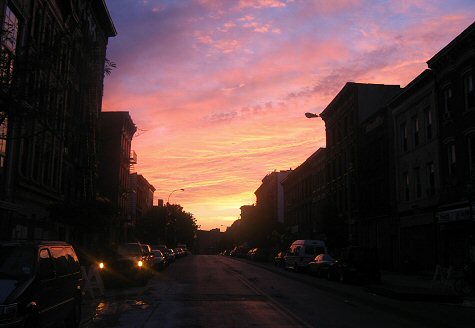
1st Street South facing west from Bedford Avenue — Monday, 6.20, 8:40 pm.

Wendy Chamberlain and James Leet, gracious co-owners of Videology (308 Bedford Ave., Brooklyn, NY 11211), easily the hippest and most refined video store in the Williamsburg area — Monday, 6:20, 8:55 pm.
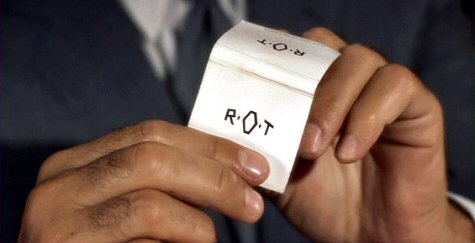
Hands belonging to a certain widely-admired, acrobat-trained actor born in Bristol, England. Letters on matchbook do not signify the initials of the character he portrays in a certain well-known thriller (from which this closeup still is derived) as much as they allude to the character’s ethical-moral state as the film begins.

Most New Yorkers know this, I’m sure, but this world-famous roller coaster at Coney Island is rather small in scale and a bit of a relic. Riding the damn thing seemed pretty thrilling to me, but my hardcore 15 year-old son Dylan says the Cyclone doesn’t cut it alongside the much scarier rides found in today’s extreme amusement parks. Plus it lasts only two minutes (if that). The fare is $5 bucks — it’s worth $3.
Dies For Our Sins
The long-awaited Criterion Collection DVD of Robert Bresson’s Au Hasard Balthazar hits the shelves on 6.14, and there’s no excuse for not going out and buying this sucker now and keeping it close for the rest of your life.
This is a great, transcendent film because it conveys and seems to truly inhabit that sense of primal serenity and all-knowingness some call God.
Set in rural France, shot in black and white and released in 1966, Au Hasard Balthazar is about the sad life and death of a donkey.

Balthazar is loved by few (a teenager named Marie, played by Anne Wiazemsky, is his most devoted soul-mate), and is mostly treated with cruelty. This poor saintly animal goes through all kinds of hell and indifference. Beaten, worked to the bone, sold and resold, shat upon.
But as critic Jim Hoberman once wrote, the film’s real concern “is the state of being. Crowned with flowers, spooked by firecrackers, struck without cause, Balthazar bears patient witness to all manner of enigmatic human behavior. This expressionless donkey is the most eloquent of creatures — he is pure existence, and his death, in the movie’s transfixing final sequence, conveys the sorrow that all existence shares.”
I’ve seen Bresson’s masterpiece twice — once a year and a half ago at the Nuart, and once in the late ’70s. I remember after my initial viewing sad and heartbreaking it felt, and how I was so turned around by the idea of a donkey being presented as the bearer of our sins — a mute observer, martyr, sufferer.
If it sounds religious to you, then so be it. I know I felt the presence of “God” (a remnant in my head of some kind of sentimental, lamenting, all-penetrating cosmic heart) in this film very clearly.
Absolute masterpieces don’t come down the pike very often. It was voted one of the 20 greatest films of all time by the critics and filmmakers who voted in 2002’s British Film Institute’s SIGHT AND SOUND poll. Film lovers have been extolling its legend for decades.
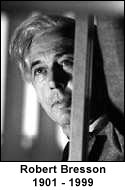
Bresson wasn’t into manipulating audiences. He began as a painter and was very conscious of unity and precision. He was into pruning down and purifying his films. He would never fake anything. He’s known for austere camerawork (he always used the same 50mm lens, which most closely replicates how the world seems to the naked eye), eschewing theatricality, and making sure his actors never gave “performances.”
Bresson’s best-known classics besides Balthazar are Diary of a Country Priest and Pickpocket. My second favorite Bresson is L’Argent (’83), his final film, made at the age of 81.
Bresson died five and a half years ago, at age 98. There are several easy-to-find Bresson websites, but here’s one of the more thorough.
More Grabs

I don’t know how good this fabled 8th Avenue seafood restaurant is (but I can guess) — what matters here is how cool it looks from the outside.
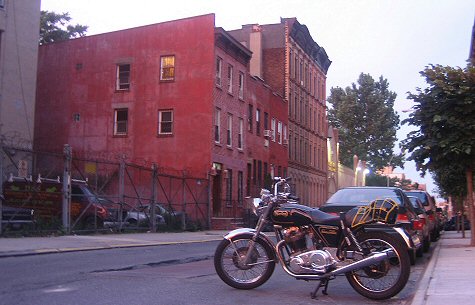
Bedford Ave. and South 1st Street, looking east — Monday, 6.20, 8:35 pm.

8th Avenue and 19th Street (or so I recall) — Sunday, 6.19, 5:40 pm

What does it matter when this shot was taken? Who cares? Even the slightly off-focus look I was going for didn’t pan out (too soupy-looking) and I almost didn’t run this as a result. But I like that glare effect from the subway car lights.

Why do people flock to Coney Island? It takes forever to get here by subway (just under an hour from Williamsburg) and believe me, it’s not much when you finally arrive. It feels crampled, provincial, unexciting…a ’60s time-capsule park. You’re ready to scoot fifteen or twenty minutes after you get there. Taken Sunday, 6.19, 2:50 pm.

Dining-car art by Claude Gazier (www.claudegazier.com).
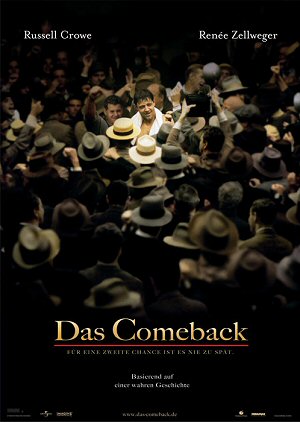
Heralding the upcoming release of Das Comeback, which will open in Germany on 9.8.05. It will open in most other European countries on this day or on 9.9. It will also open around this time in Argentina, where it will be called El Luchador (“The Fighter”), according to a director friend from Buenos Aires.
When Cinderella Man opens theatrically
When Cinderella Man opens theatrically in England and Europe in early September, will local distribs be using a different title? I ask because a lot of people stateside felt that the vaguely pansy-ish Cinderella Man title may have been one of the reasons the ’30s boxing saga didn’t perform up to expectations, and because the title being used in Germany (where the Ron Howard film is opening September 8) is Das Comeback. It’s routine for films to be retitled for European audiences in the local vernacular, of course. Finding Neverland was retitled for Germany as Wenn Traume fliegen lernen (i.e., When Dreams Learn to Fly) and Wes Anderson’s The Life Aquatic with Steve Zissou was renamed in Germany as Die Tiefseetaucher (The Deep Divers). In France Cinderella Man will be getting a typically native translation — it’s going to be called De l’ombre a la lumiere, which translates as From the Shadows to the Light. A director friend from Argentina tells me it’s going to be called El Luchador (“The Fighter”) when it opens there in September.
